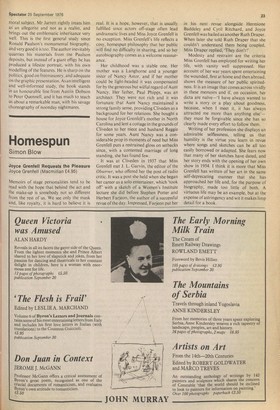Contrasts
Pat Rogers
Josiah Wedgwood Anthony Burton (Andre Deutsch £4.95) The ingenious Mr Hogarth Derek Jarrett (Michael Joseph £7.00)
Samuel Smiles wrote a life of Wedgwood, and the good Josiah certainly helped himself to some glittering industrial prizes--but he deserved them. When he started out pottery was a peasant craft and Staffordshire an economically minor county. His career was one long improvement of the estate; nothing could be more eighteenthcentury than the mock-heroic gesture of building Etruria on the banks of the Trent. His ware joined the useful to the ornamental, with true Horatian propriety. He set out to 'conquer France in Bursleni by reproducing 'the elegance and simplicity of the Ancients', and he allowed Flaxman to create classical designs in shallow relief. 'The contrast between the blues and greens and the pure white of the applied figures,' says Mr Burton, 'exactly hit the mood of cool elegance that characterised the taste of the age.' His wellwrought urns were exported to the entire civilised world: Catherine the Great ordered a vast dinner service decorated with views of picturesque England and Wales. A man was sent out to Keele and Shugborough to look for appropriate sites.
Commonplace Wedgwood was not, but how sublimely ordinary, through his steady promotion from corporal in the family busi
ness to captain of industry. 'I scarcely know,' he wrote, 'whether I am a landed gentleman, an engineer or a potter, for indeed I am all three and many other characters by turns.' We find him manufacturing and selling, planting and uprooting, reading Thomson and visiting Bath. He married his cousin and haggled over the settlement; he submitted himself to hacksaw surgery and worried about his eyesight. His brother was found in the Thames after an evening at Ranelagh: his nephew ran off to the stage and then to America, like the implausible drop-outs in Goldsmith and Smollett. But Wedgwood marched doggedly on, st.itained by his patient research, his efficient productionline, his discreet flattery of important clients. Turnpikes and canals were needed to open up the market; if Wedgwood had lived fifty years later the Euston line would have gone 'to Stoke and not to Crewe. Wedgwood was like a hundred other trading magnates, with more drive and a little more breadth of vision. What Boulton did with buttons he achieved with fine ceramics.
Anthony Burton has written a lively, workmanlike biography, particularly good on the industrial background. Where the Victorian compilers struggled to keep up a jog-trot, he manages an easy narrative canter. He tells some good stories, and a few of them may be true: it is nice to find Erasmus Darwin (who once designed a windmill for Wedgwood) giving ophthalmic advice—everyone, he said, had spots in front of their eyes, 'but everybody did not look at them.' Mr Burton is too hard on Anna Seward, and absurdly patronising towards James Thomson, whose 'dire' poetry changed the English consciousness. Broader aspects of Hanoverian culture and society often catch the author out; he thinks Wilkes wrote for a paper called North Britain, and seems ill at ease with the politics. But then Wedgwood was not really a political animal. just vaguely humanitarian and Whiggish where it did not touch his pocket or interrupt his experiments.
Hogarth is another matter: his jumbled career, his prickly and emulous nature, his anger and his neurosis all belong to a contemporary anti-hero. Like the other childless Augustans—Swift, Pope, Johnson—he was alienated by his sterility in a teeming, fecund world. And his very art was divided: 'He painted for the few and engraved for the many,' as Derek Jarrett aptly puts it. Dependent on connoisseurs whom he scorned. Hogarth aspired to noble and sentimental history even as he perfected the modern
moral subject. Mr Jarrett rightly treats him as an allegorist and not as a realist, and brings out the emblematic inheritance very well. This is the first general study since Ronald Paulson's monumental biography, and very good it is too. The author inevitably quarries his materials from tne Paulson deposits, but instead of a giant effigy he has produced a lifesize portrait, with his own modelling of the features. He is sharp on the politics, good on freemasonry, and adequate on the graphic presentation. Asan intelligent and well-informed study, the book stands in an honourable line from Austin Dobson to Peter Quennell, and it has much to teach us about a remarkable man, with his savage choreography of noonday nightmares.



































 Previous page
Previous page